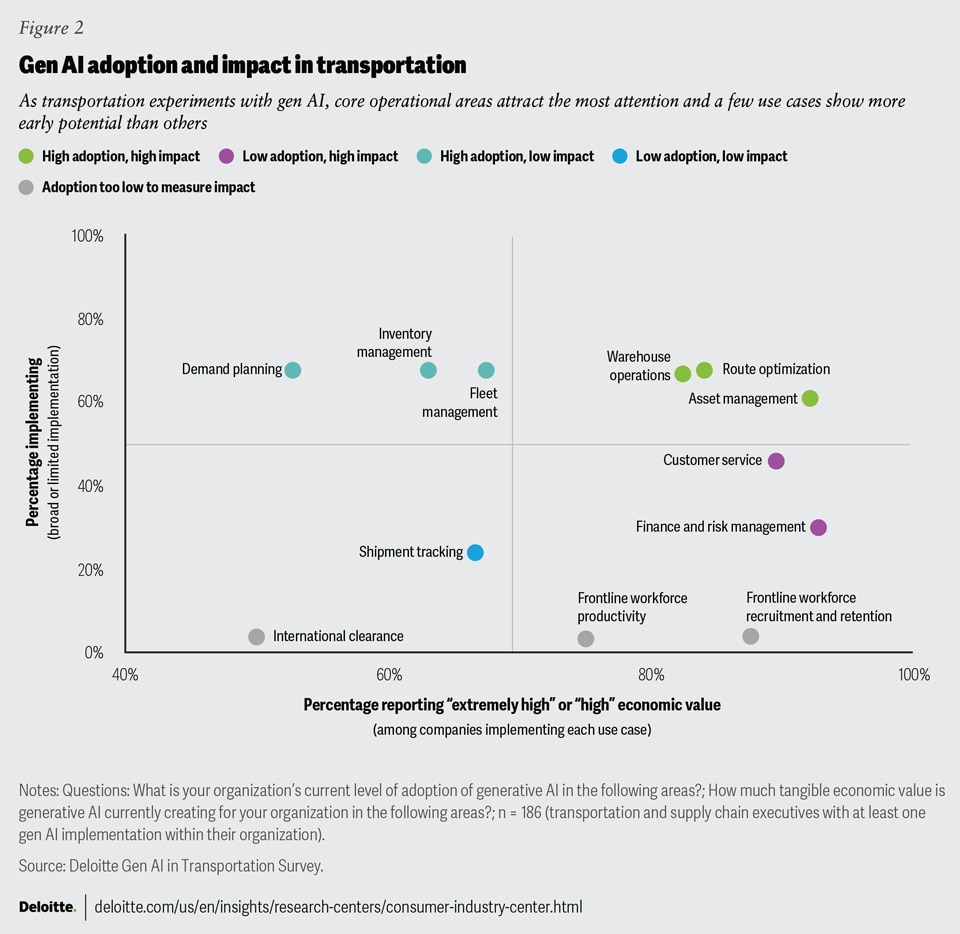Earlier this year, at CES 2025, we saw a bevy of innovative technologies aimed at making the transportation industry more productive, safer, and more energy efficient. For today’s blog, it’s time to zoom in on three significant movements underway that will impact transportation in 2025 and beyond.
The race is on in the transportation industry because of slimmer margins, greater demands from shippers and regulators, security, and what seems to be the same discussion in every industry, a worker shortage, just to name a few. But, perhaps, one of the biggest changes is the quick rise of gen AI in the past few years, which is set to alter how the industry performs business in the years to come.
Gen AI Drives Transportation
More than half of transportation companies have active gen AI implementation, according to Deloitte’s 2024 survey, but the greatest challenge is they are still stuck to a few aspects of the business. The most common areas for transportation businesses to leverage gen AI today are in areas like supply chain, sales and marketing, and strategy and operations. Consider asset management, route optimization, and warehouse operations, as a few examples.

Interestingly, 99% of transportation executives anticipate the technology will transform transportation at some point—yet more than 71% expect this transformation to take more than three years. So, while the opportunities are endless with gen AI, it will not happen overnight. And in fact, it will more likely take time to adapt to these new opportunities.
Looking across all industries to the year ahead, Deloitte forecasts 25% of enterprises using gen AI will deploy AI agents this year. This will grow to 50% by 2027. Meanwhile, looking at the overall benefits of the technology itself, Gartner anticipates 33% of enterprise software applications will leverage agentic AI by 2028, which is a bump from less than 1% in 2024. AI agents are coming to advance technology—and we will soon leverage them.
New Transportation Leadership
Politics aside, we do have a new administration and a new head of the DOT (Dept. of Transportation) coming in the United States. While things are still taking shape in Washington, Sean Duffy has been sworn in to head up the organization, and there is still much to learn about his vision for transportation and infrastructure here in the United States. In a statement, he made it clear he is “Hard at work executing the President’s vision to usher in a golden age of transportation by taking immediate action to remove government overreach and lower costs for hardworking Americans.”
This will certainly be interesting, especially since we will have America’s Infrastructure Report Card from the ASCE (American Society of Civil Engineers) coming to us this spring and we all know this has been very dicey.
In a recent statement, Feniosky Peña-Mora, P.E., president, ASCE, says the organization is eager to work with Secretary Duffy and the DOT to maintain and modernize the nation’s vital infrastructure systems and urges the new administration to continue investments in our nation’s transportation network.
Thus, we have much to consider for transportation and infrastructure in the days ahead and certainly much work to be done. Stay tuned.
What’s the Scope?
One thing we need to continue to keep an eye on as it relates to transportation trends are Scope 1, 2, and 3 considerations, and how technology can help here, which is something I have talked about at length here on the blog.
Scope 1 and Scope 2 are straightforward, covering the greenhouse gas emissions that a company makes directly and indirectly, respectively. Scope 3 is a bit trickier because this is where the supply chain enters the conversation. This category is associated with everything else upstream and downstream.
A new emissions calculator aims to help here, as it is designed to help with LTL (less than truckload) transportation Scope 3 emissions reporting. To help, SMC³ emissions calculator is available in the Cost Intelligence System, which automates carbon data reporting.
While this is simply one example, the bottomline is calculating Scope 3 emissions can be challenging, but many recent technologies are becoming available to make the process a little bit easier.
What’s Next?
When it comes to transportation, we must always be forward-thinking. We cannot think about what we have now, but what is the intent for our future, otherwise we are missing the goal for what’s on the horizon, or more importantly, what’s to come next.
At the end of the day, we must plan for the future of transportation, and we must leverage innovative technologies aimed specifically at the transportation industry to improve productivity, safety, and energy efficiency. Keep an eye on this in the year ahead.
Want to tweet about this article? Use hashtags #IoT #sustainability #AI #5G #cloud #edge #futureofwork #digitaltransformation #green #ecosystem #environmental #circularworld #transportation


